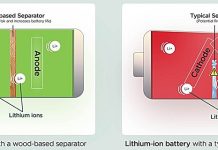
Researchers at the Technical University of Denmark (DTU) have developed a new type of ceramic electrolysis cell that can produce hydrogen more efficiently and at a lower cost.
These cells use new electrodes made of nickel and gadolinium-doped ceria (Ni-GDC) and have shown promising results after 1,000 hours of testing.
Electrolysis cells are crucial for converting green electricity from wind turbines and solar panels into fuels like hydrogen, methanol, and ammonia.
These fuels can help reduce CO2 emissions and promote sustainable transportation and industry.
The DTU team, led by Professor Henrik Lund Frandsen, tested the new Ni-GDC fuel electrodes and found that they maintained their performance over time, without wearing out.
This increased durability could lead to significant savings in material costs and reduce the price of green hydrogen by up to 5%.
“If we can implement ceramic electrolysis cells in power-to-x (PtX) technology worldwide, their efficiency could save 25% of the electricity needed to produce green fuel and reduce the price of hydrogen by up to 20%.
Improving the lifespan of the cells will also result in material savings, reducing costs by an additional 5%,” Frandsen explained.
The tests, conducted by postdoc Morten Phan Klitkou and his team, involved running the cells at different currents for 1,000 hours.
The results showed only slight degradation in the fuel electrode’s resistance at very high current draws.
This is a significant improvement over conventional ceramic electrolysis cells, which typically degrade under similar conditions. The nickel in the new electrodes remained stable, even under high stress.
However, the researchers encountered a new issue with the electrolyte in the electrolysis cells. Despite this complication, they are optimistic about the potential of Ni-GDC cells and believe they offer a scalable solution for creating efficient and long-lasting electrolysis cells.
Hydrogen production through electrolysis is essential for the green transition. The first step in any PtX process is to produce hydrogen, which can then be used to make various green fuels.
In the future, large amounts of power from wind turbines and solar cells, including energy from two planned energy islands in the North Sea and on Bornholm, will be used to produce these fuels.
This green electricity will power applications that are difficult to electrify, such as heavy road transportation, aviation, shipping, and various industrial processes.
In Denmark, a lot of research and development in ceramic electrolysis cells has been carried out through a collaboration between the company Topsoe and DTU researchers. In 2014, they entered a license agreement to manufacture and develop ceramic electrolysis cells (SOEC).
This led Topsoe to begin building the world’s first large-scale factory to produce high-temperature electrolysis cells in Herning.
The factory, set to open in 2025, will initially produce 500 MW of electrolysis units annually, expanding to 5 GW by 2030.
Frandsen estimates that it will take up to ten years for Ni-GDC electrolysis cells to be fully scaled up and used in PtX plants worldwide.
Source: KSR.



